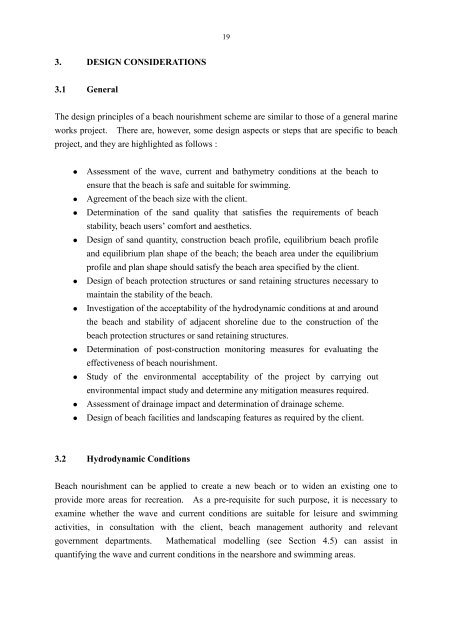PORT WORKS DESIGN MANUAL PART 5 Guide to Design of ...
PORT WORKS DESIGN MANUAL PART 5 Guide to Design of ...
PORT WORKS DESIGN MANUAL PART 5 Guide to Design of ...
Create successful ePaper yourself
Turn your PDF publications into a flip-book with our unique Google optimized e-Paper software.
19<br />
3. <strong>DESIGN</strong> CONSIDERATIONS<br />
3.1 General<br />
The design principles <strong>of</strong> a beach nourishment scheme are similar <strong>to</strong> those <strong>of</strong> a general marine<br />
works project. There are, however, some design aspects or steps that are specific <strong>to</strong> beach<br />
project, and they are highlighted as follows :<br />
• Assessment <strong>of</strong> the wave, current and bathymetry conditions at the beach <strong>to</strong><br />
ensure that the beach is safe and suitable for swimming.<br />
• Agreement <strong>of</strong> the beach size with the client.<br />
• Determination <strong>of</strong> the sand quality that satisfies the requirements <strong>of</strong> beach<br />
stability, beach users’ comfort and aesthetics.<br />
• <strong>Design</strong> <strong>of</strong> sand quantity, construction beach pr<strong>of</strong>ile, equilibrium beach pr<strong>of</strong>ile<br />
and equilibrium plan shape <strong>of</strong> the beach; the beach area under the equilibrium<br />
pr<strong>of</strong>ile and plan shape should satisfy the beach area specified by the client.<br />
• <strong>Design</strong> <strong>of</strong> beach protection structures or sand retaining structures necessary <strong>to</strong><br />
maintain the stability <strong>of</strong> the beach.<br />
• Investigation <strong>of</strong> the acceptability <strong>of</strong> the hydrodynamic conditions at and around<br />
the beach and stability <strong>of</strong> adjacent shoreline due <strong>to</strong> the construction <strong>of</strong> the<br />
beach protection structures or sand retaining structures.<br />
• Determination <strong>of</strong> post-construction moni<strong>to</strong>ring measures for evaluating the<br />
effectiveness <strong>of</strong> beach nourishment.<br />
• Study <strong>of</strong> the environmental acceptability <strong>of</strong> the project by carrying out<br />
environmental impact study and determine any mitigation measures required.<br />
• Assessment <strong>of</strong> drainage impact and determination <strong>of</strong> drainage scheme.<br />
• <strong>Design</strong> <strong>of</strong> beach facilities and landscaping features as required by the client.<br />
3.2 Hydrodynamic Conditions<br />
Beach nourishment can be applied <strong>to</strong> create a new beach or <strong>to</strong> widen an existing one <strong>to</strong><br />
provide more areas for recreation. As a pre-requisite for such purpose, it is necessary <strong>to</strong><br />
examine whether the wave and current conditions are suitable for leisure and swimming<br />
activities, in consultation with the client, beach management authority and relevant<br />
government departments. Mathematical modelling (see Section 4.5) can assist in<br />
quantifying the wave and current conditions in the nearshore and swimming areas.

















